Preface: With the beginning of 2018, Syrian regular forces starts dropping flyers over several cities and towns in Eastern Ghouta-Damascus countryside, specifically in January and February 2018. The flyers contain threats to civilians, in an attempt it could be interpreted to push people to leave their cities and towns, in a scenario similar to what happened in Aleppo city in 2016. As it was stated by Russian Foreign Minister Sergey Lavrov on February 19, 2018: “experience in liberating Aleppo is applicable in Eastern Ghouta.”
It should be noted that dropping flyers on Eastern Ghouta coincided with a brutal military campaign launched on its cities and towns by pro-government forces who targeted civilian objects and medical facilities there, besides their use of toxic gas and chemical substances repeatedly, committing dozens of war crimes,
According to STJ field researcher, a large number of flyers were dropped prior or concurrently with military operations, in particular during the recent military campaign[1] launched by the Syrian regular forces on Eastern Ghouta cities and towns, as From February 18, 2018. Pro-government forces had earlier dropped flyers on civilian gatherings in Eastern Ghouta, during their former military escalation, which began on December 29, 2017, coinciding with the Ahrar al-Sham al-Islamiyya’s announcement of the second stage[2] of "They Were Wronged” battle.
The Syrian army frequently drops leaflets and flyers over areas controlled by ISIS or other armed groups. The flyers typically have a dual function. On the one hand, they warn of an upcoming attack by the Syrian army and on the other, they threaten with death those who do not surrender or evacuate a certain area.
On February 18, 2018, Eastern Ghouta cities and towns were subjected to one of the heaviest military campaigns launched by the Syrian regular forces and their allies, who used numerous types of weapons, targeting civilian gatherings in those areas, whether by warplanes, helicopters or heavy artillery, which resulted in numerous causalities, dead or wounded.[3] According to the field researcher of STJ the campaign has left more than 400 civilian deaths, counting from the day it begins to the date of preparation of this report.
STJ had earlier prepared a report entitled “As If it’s Doomsday!” which covered the flow of events in Eastern Ghouta.
During this campaign, specifically on February 22, 2018, the Syrian regular forces helicopters dropped flyers on civilian gatherings in the city of Duma[4]. This was confirmed by Osama al-Nabki, an activist from Duma, who said:
"At 5:23 p.m., while one of the helicopters was throwing barrel bombs on the city of Duma, the same helicopter dropped several flyers on populated areas in the city, such as the "Al Alia "and "Al Manarah". I was curious to read what written on those flyers so I caught one and hurried back to the cellar to take shelter from bombardment. At first glance, I started laughing and mocking regime’s written words, because we are sure of its lack of credibility, we are also convinced that the dropping of these flyers is only a matter of psychological warfare to compel us to surrender. These flyers contain both clear and veiled threats, given that the regime considers every civilian in Eastern Ghouta a mere supporter for militants, and see him/her as a terrorist.”
Al-Nabki continued that people of Duma made mockery of those flyers, as how could the Regime who blocked the evacuation of the sick and wounded to receive treatment outside Eastern Ghouta, to offer thousands of civilians safe passage, he added:
"The regime should’ve stop shelling our women and children who languish inside their houses. It already has killed thousands of them due to the besiegement policy it pursued and its blockade of food and medicine’s entry into Eastern Ghouta. It is known that all the people of Eastern Ghouta are revolutionaries and opponents of the regime who arrested and displaced them over the years, and we are not naïve to trust the regime after everything that has happened. It is clear that what it wants is to displace us and keep us away from our hometown.”

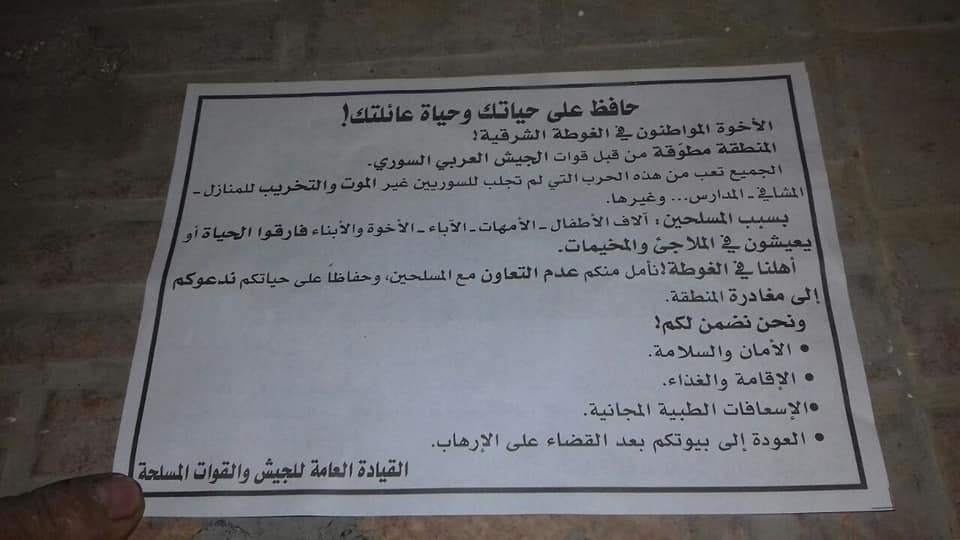
Images showing some of the flyers dropped by the Syrian regular forces' helicopters on Duma city on February 22, 2018.
Photo credit: media activists from Duma.
On March 11, 2018, Syrian government forces dropped flyers on Duma city-Damascus countryside, informing people that they had identified crossings for for civilians wanting to leave the enclave safely into special areas prepared for them "safe passage".
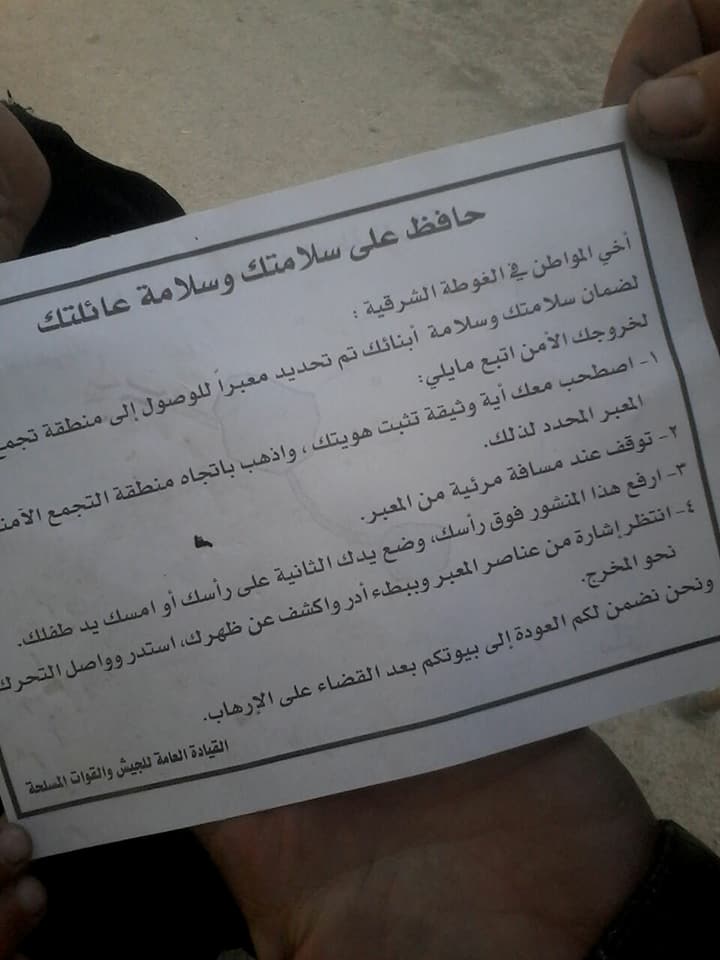
Image (1) shows one of the flyers dropped on Duma city on March 11, 2018.
Photo credit: Residents and activists from the city.
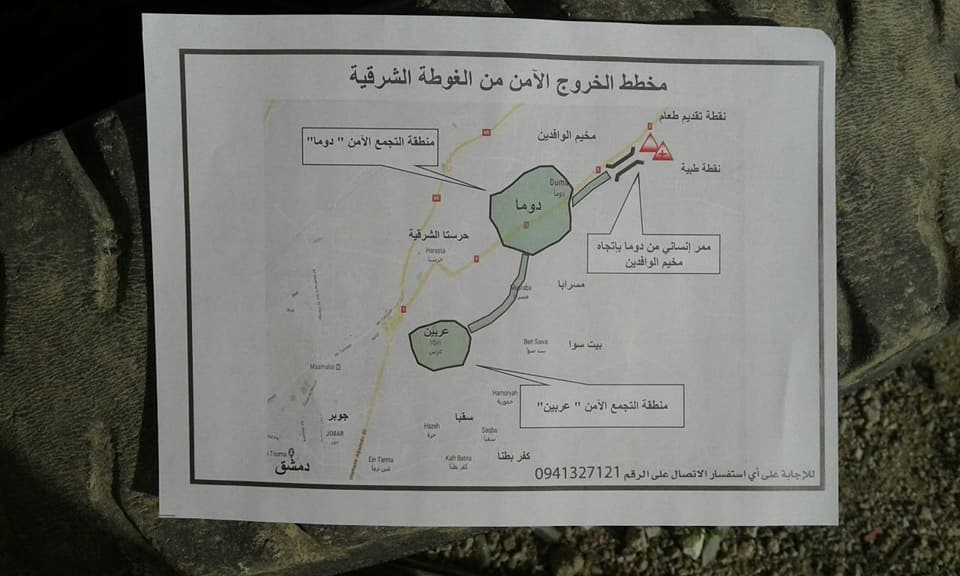
Image (2) shows one of the flyers dropped on Duma city on March 11, 2018.
Photo credit: Residents and activists from the city.
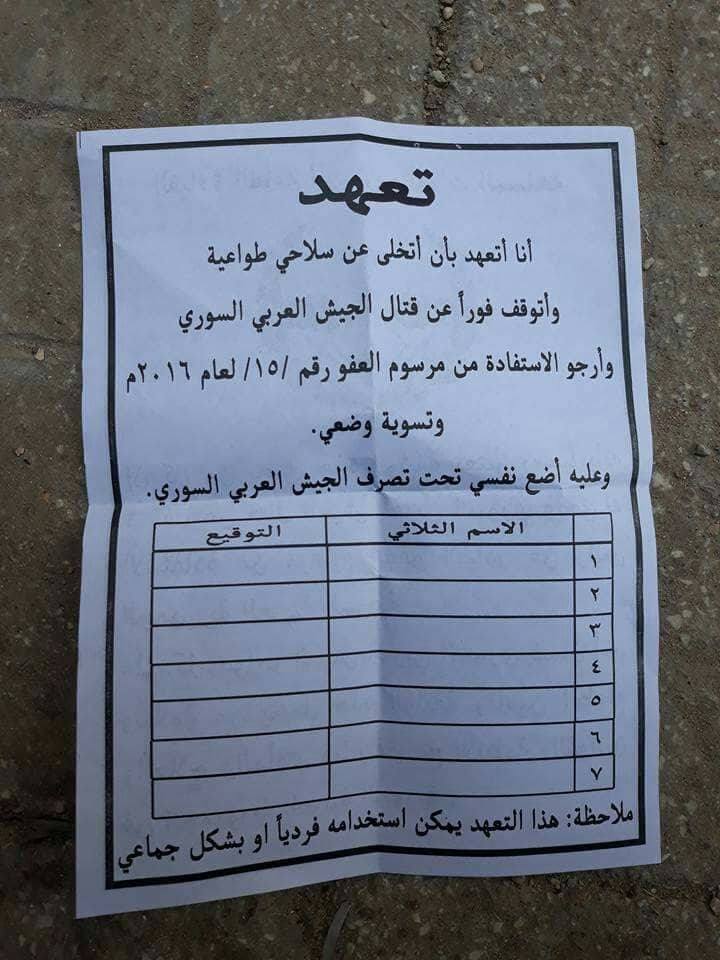
Image T (1) shows one of the flyers dropped over Duma on March 3, 2018, which is an empty "pledge" to be filled by the combatants who agree to lay down their arms and surrender to the Syrian regular forces.
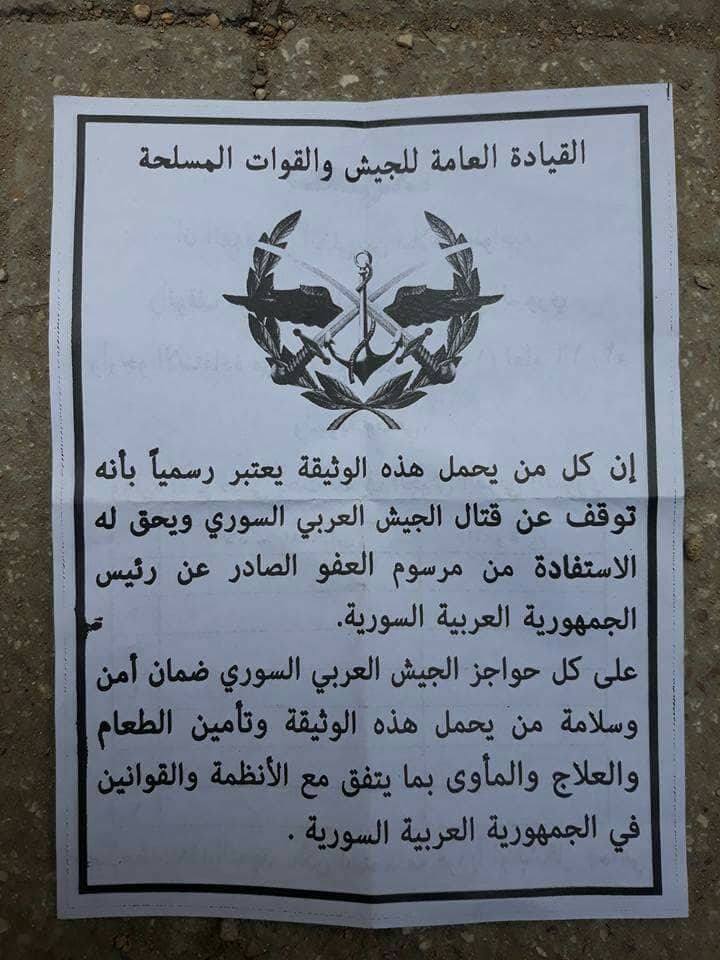
Image (2) shows another flyer from those dropped on Duma-Eastern Ghouta, on March 3, 2018. The flyer says that it is an "official document" proves that the one holding it ceased fighting against the Syrian Regular Army.
Photo credit: People and activists from Duma.
Pro-government Facebook pages published video footages filming the military helicopters dropping flyers on Eastern Ghouta cities and towns in Damascus countryside.
Official accounts of SANA news agency published, news and videos on dropping flyers over the cities and towns of Ghouta at the beginning of March 2018.
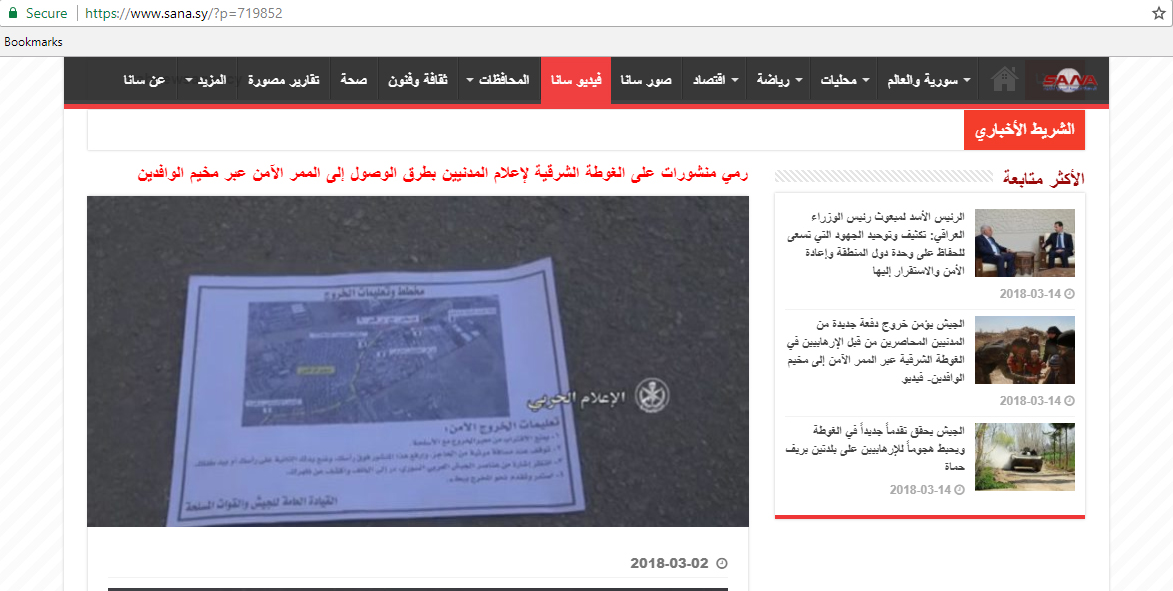
Image (1)
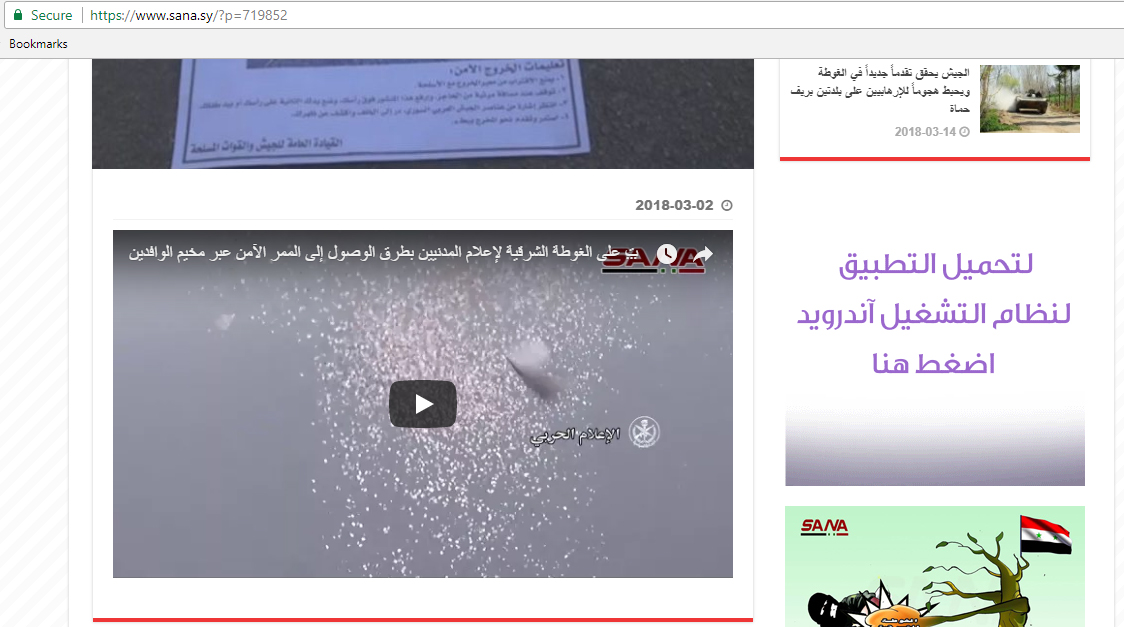
Image (2)
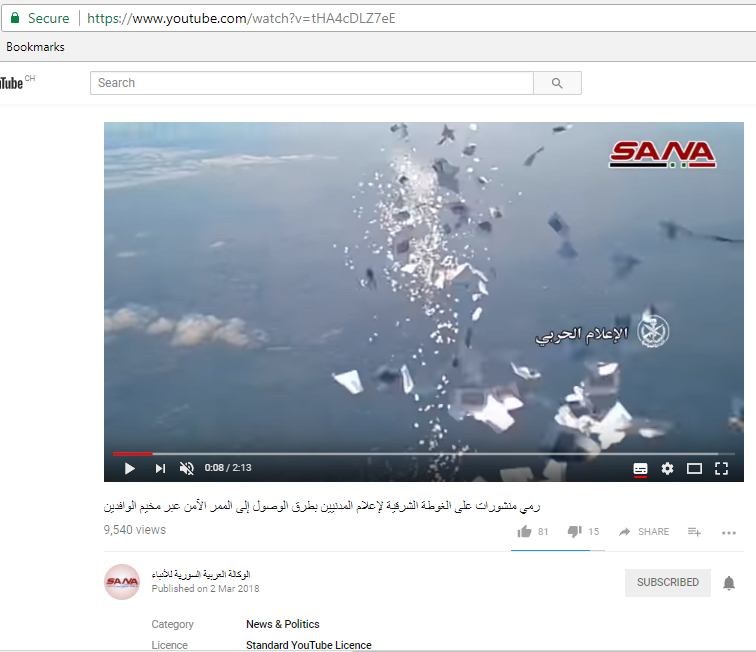
Image (3)
Images (1), (2) and (3) taken from the official website of SANA, the official news agency, and from videos on its YouTube channel.
On December 29, 2017, the Syrian regular forces and their allies launched a violent military campaign on Eastern Ghouta cities and towns, coinciding with Ahrar al-Sham al-Islamiyya Movement’s announcement of the second stage[5] of "They Were Wronged" battle. Harasta[6] city had the greatest share of shelling, where it was subjected to a non-stop artillery and aerial bombardments by the Syrian regular forces and their allies, which resulted in many civilian casualties killed or wounded. That led many East Ghouta people to shelter inside cellars for fear of violent shelling.
STJ has issued a detailed report on this military escalation entitled " Horrific Massacres by the Syrian-Russian Alliance in Eastern Ghouta, during the Run-Up to Sochi Congress "for National Dialogue", which was prior Sochi Congress, on 29 and 30 January 2018.
During this campaign, specifically on January 7, 2018, the Syrian regular forces military aircraft dropped several flyers on the neighborhoods of Harasta city, which was confirmed by "Muhammad Abbas- an alias" to an activist from Harasta City, where he said:
"At 2:00 pm, the Regime's warplanes threw a rocket on the city, but we didn't hear any explosion sound which is unusual. We tried to go up to see what happened, but we couldn't make it because the Regime never stop shelling the city. Almost four hours later, we were able to go up and we saw many flyers on the ground, some of which had vague and unclear phrases, some addressed militants and others to everyone of the population.”
Abbas said that the flyers were only a veiled threat to many civilians in Harasta, citing the violent bombing campaign that preceded the dropping of those flyers and targeted the civilian gatherings in the city, noting that this Syrian regular forces’ military campaign left scores of dead and wounded among civilians, mostly children and women. He continued:
"The Syrian regime dropped those flyers over " Samsam" neighborhood in Harasta city, which is known to be one of the most densely populated neighborhoods, where there is no military presence. If the regime had wanted to address the militants, it should’ve dropped flyers over the battlefronts, and the Syrian regime had deliberately thrown these flyers after a systematic bombing campaign, to make us collapse psychologically and physically, to surrender to its demands, but when many of the people in Harasta city saw these flyers, they felt like they are absurdity, as the regime who hit us with all types of missiles day and night, block food and medicine, and ignored names on evacuation lists who were in dire need to receive treatment, will never have mercy on us and will not allow anyone to live peacefully.”
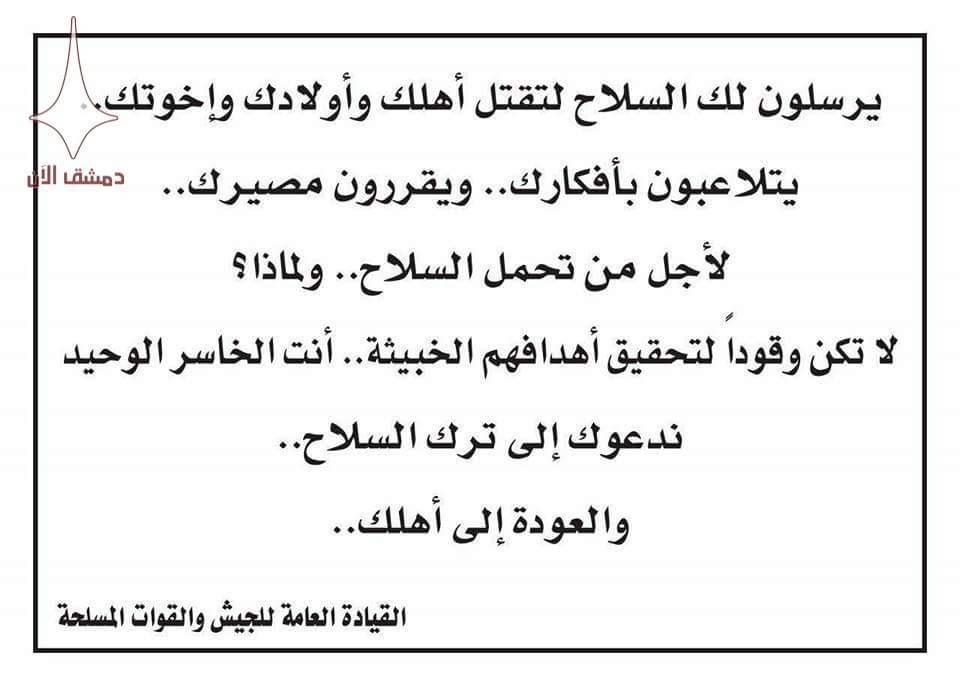
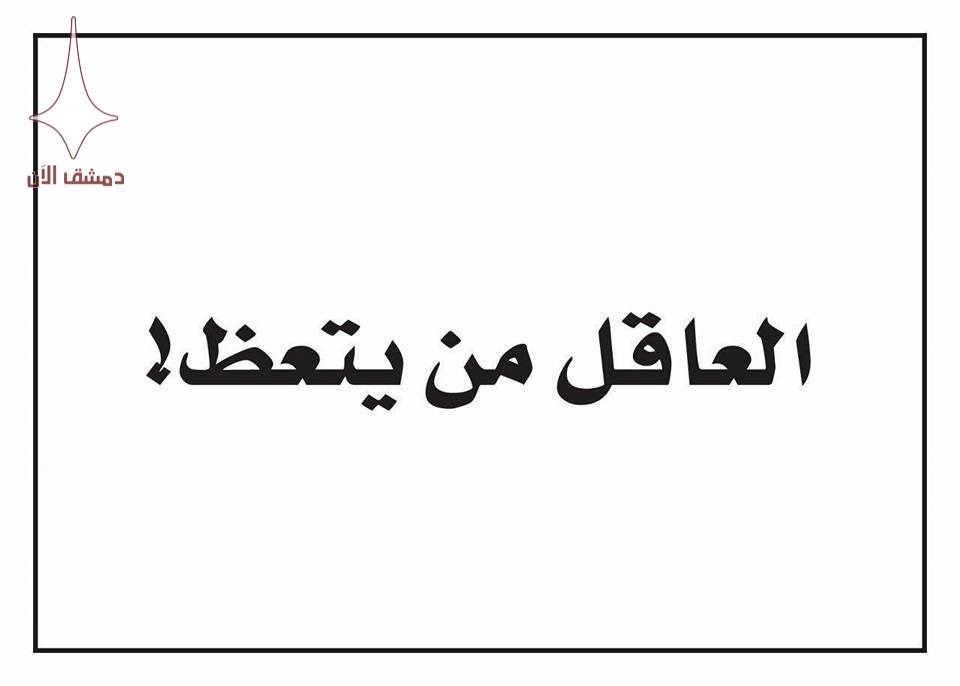

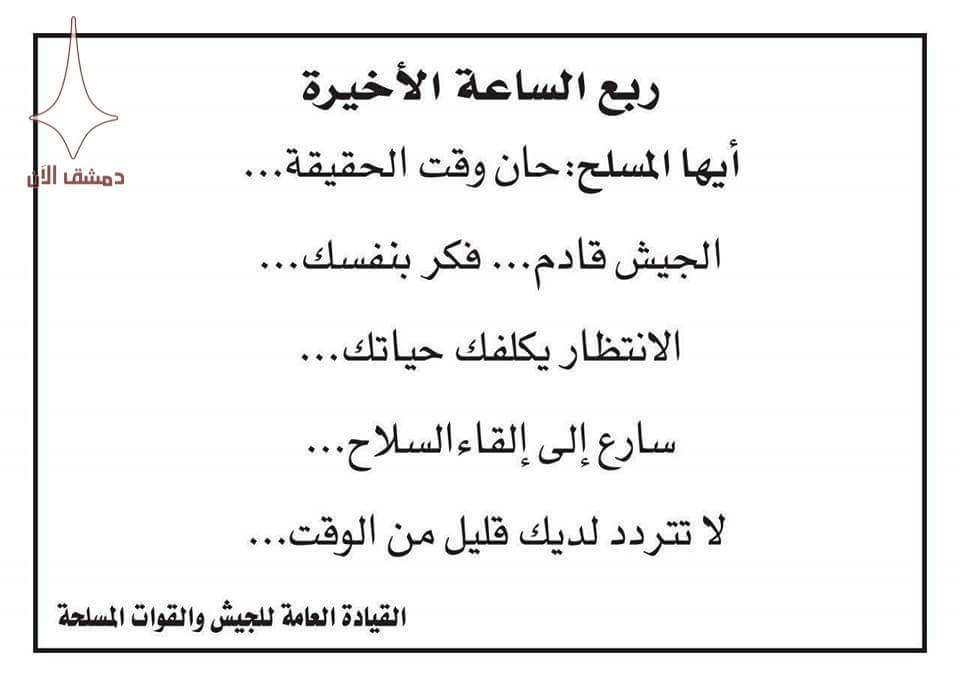
Images showing a collection of flyers dropped over Harasta city on January 7, 2018.
Photo credit: Dimashq al Aan “Damascus now” a pro-government Facebook page.
The legal framework
This paper will examine the legal framework applicable to these communications and determine whether they comply with international humanitarian law. In particular it will focus on:
(i) whether the warning of an upcoming attack is required by and complies with the rules applicable to the principle of precaution; (ii) whether the promise of safe passage contained in some of the flyers amounts to perfidy; (iii) whether the threat to kill those who do not surrender constitutes a violation of the prohibition of denial of quarter.
The principle of precaution
The principle of precaution requires to take constant care in the conduct of military operations in order to spare the civilian population and civilian objects.[7] To that end, all feasible precautions must be taken in the conduct of military operations.[8] The principle is aimed at avoiding, or at least minimising, the incidental effects of a conflict on persons and objects that are not legitimate targets of attack.[9]
The rules on precautions are conceived as a prerequisite for parties to a conflict to respect other principles and rules on the conduct of hostilities.[10] The fundamental principle requiring belligerents to distinguish at all times between the civilian population and combatants can only be applied if the parties to the conflict take steps to verify the nature of the target they are about to attack.[11] At the same time, the rules on precautions supplement the aforementioned principle of distinction and interlinks with rules on proportionality. If a military objective is targeted and the principle of proportionality is respected, meaning that the expected incidental loss of civilian life is not excessive in relation to the concrete and direct military advantage anticipated from the attack, precautionary measures must nevertheless be taken.
Elements of the principle of precaution are present in the 1907 Hague Convention,[12] the 1907 Hague Regulations[13] and in the Fourth Geneva Convention,[14] but the principle is expressly formulated only in articles 57 and 58 of the Additional Protocol I to the Geneva Conventions (AP I). AP I regulates conflicts of an international character (IAC) and as such is not relevant to the Syrian conflict. However, the principle of precaution, as confirmed by International Criminal Tribunal for the former Yugoslavia (ICTY) in the Kupreškić case, forms part of the corpus of customary international humanitarian law and is applicable to all parties to the conflict also in non-international armed conflicts.
The content of the customary rules on precaution is spelt out by Rules 15 to 24 of the ICRC study on customary international humanitarian law. Those who plan and decide on an attack are bound by the obligation to take all feasible precaution before[15] and during all phases of the attack[16]. Furthermore, the same obligation applies also to the party to the conflict which is subject to the attack in relation to the civilian population under its control.[17] In particular, the party subject to the attack must, to the extent feasible, avoid locating military objectives within or near densely populated areas and must remove civilian persons and objects under its control from the vicinity of military objectives.[18]
The precautionary obligation that is most relevant for purpose of this paper is the obligation to give an effective advance warning of attacks which may affect the civilian population, unless circumstances do not permit it.[19] According to state practice, a warning is not required when the element of surprise is crucial for the attack, or more generally when the warning could compromise the success of the attack or the security of troops.[20] Dropping flyers warning of an imminent attack may, in theory, be considered an advanced warning in compliance with the principle of precaution. However, the warning must also be effective. In order for a warning to be effective it must be sufficiently timely and specific to enable the civilian population to act upon it.[21]
Moreover, even assuming that the warnings are sufficiently specific to constitute an implementation of the principle of precaution, their adoption cannot justify violations of other norms of IHL.[22] Providing advance warning does not mean that the following attack will be lawful under other IHL norms.[23] In particular, the mere fact that civilians do not leave following a warning does not affect per se their status as persons immune from attacks under IHL.[24] In circumstances in which warnings are addressed to an area under siege, the attacking party remains under the obligations not to use starvation as a method of warfare[25] and to allow the delivery of humanitarian relief.[26] In addition, those who leave following the warning of an upcoming attack must not be forcibly displaced unless the displacement is motivated by imperative military necessity or it is necessary to ensure the safety of the civilian population.[27]
In the context of the conflict in Gaza it was advanced the argument according to which civilians who do not leave following a warning are acting as voluntary human shields, thus becoming legitimate military objectives.[28] In most circumstances this argument is to be rejected as in the first place under international law, civilians have no obligation to leave after being warned.[29] Secondly, civilians become legitimate targets only if they directly participate in hostilities.[30] Although it is true that civilians acting as voluntary human shields may be considered to directly participating in hostilities,[31] not leaving a war zone following a warning is not sufficient evidence for the qualification of the civilian as voluntary human shield.[32] It is extremely difficult to demonstrate with certainty the existence of an hostile intent from such a decision and in case of doubt civilians are presumed to be civilians and cannot be directly targeted.[33]
Finally, civilians who do not leave following the warning continue to benefit from the other precautionary measures that ought to be taken by the attacker, or be a basis for any IHL breaches[34]
Vague and Veiled Warnings
The warnings contained in the flyers dropped by the Syrian government are too vague to constitute an effective advanced warning; arguably their only effect is to create terror amongst the civilian population, thus violating the customary prohibition to spread terror amongst the civilians.[35]
Perfidy
Additional Protocol I defines perfidy as “acts inviting the confidence of an adversary to lead him to believe that he is entitled to, or obliged to accord, protection under the rules of international law applicable in armed conflict, with intent to betray that confidence”. The prohibition of perfidy is not included in Additional Protocol II, regulating conflicts of a non-international character, but it constitutes a norm of customary international humanitarian law and is applicable also in the context of the Syrian conflict.[36]
In several occasions, flyers of the Syrian government promised safe passage to those who surrendered and more generally to anyone not carrying a weapon. The wording of the flyers seems to suggest that combatants that surrender would be treated as individuals hors de combat and protected accordingly.[37] It also seems to suggest that civilians not carrying a weapon would be left unharmed. Targeting an individual who is made to believe to be under the protection guaranteed by IHL to civilians or combatants hors de combat, constitutes a violation of the prohibition of perfidy.[38] Moreover, pursuant to article 8(2)(e)(ix) of the Rome Statute of the International Criminal Court (Rome Statute), the same conduct constitutes a war crime in a non-international armed conflict.
Denial of quarter
The prohibition to order that no quarter will be given is a precondition governing the application of all the rules of protection of IHL. Any guarantees of humane treatment, any rule on care to be given the wounded and sick, and any judicial guarantees would remain a dead letter if conflicts were conducted on the basis of orders to exterminate the enemy.[39]
The prohibition originates in Article 23 of the 1907 Hague Regulations and is contained in article 4 of Additional Protocol II.[40] AP II does not apply to the Syrian conflict as Syria is not a party to the conflict. However, the prohibition of denial of quarter now forms part of customary international humanitarian law and is binding also on Syria.[41] Denial of quarter is a grave breach of international humanitarian law and constitutes a war crime in a non-international armed conflict in conformity to Article 8(2)(e)(x) of the Rome Statute.
The prohibition includes both ordering or threatening an adversary that no quarter will be given, and conducting hostilities on the basis that no quarter will be given.[42] Conducting hostilities on the basis that no quarter will be given also violates common Article 3 of the Geneva Conventions because it would result in the killing of persons hors de combat.[43] This rule does not require the parties to the conflict to first employ non-lethal means against a lawful target, or to capture of detain before trying to kill.[44] However, it prohibits the parties to the conflict to refuse to save the lives of enemy combatants if they surrender or are otherwise placed hors de combat.[45] According to the ICRC, this rule also requires – when circumstances reasonably permit it – to give an adversary endeavouring to do so the opportunity to surrender.[46] It follows, that methods of warfare calculated to ensure the complete extermination of the opposing forces, including the wounded and sick and those attempting to surrender, would be in violation of the prohibition of denial of quarter.[47]
The flyers dropped by the Syrian government on areas controlled by armed groups usually offer the opportunity to surrender. Nevertheless, they also expressly state (or sometimes imply) that anyone who does not surrender immediately will be killed. This approach is incompatible with the requirement that the attacking forces remain receptive to a declaration of surrender should the opportunity arise.[48] Moreover, it constitutes a violation of the prohibition to threaten the adversary with denial of quarter.
[1] On February 17, 2018, pro-government forces and militias mobilized a very large number of vehicles and soldiers on several adjacent points for Eastern Ghouta, according to military sources, these crowds were as a part of preparations for the military operations in which “Tiger Forces”, affiliated to "Suheil al-Hassan” nicknamed The Tiger, al-Nimr, are involved, to control the Eastern Ghouta region. This campaign has begun with intense bombardment, since February 18, 2018.
[2] This campaign started on November 15, 2017, following Ahrar al-Sham al-Islamiyya Movement’s announcement of its three-stage battle "They Were Wronged"in order to control the "Military vehicles Management", held by the Syrian army, in Harasta. The first stage began on November 14, 2017, in which the fighting resulted in the kill of a number of Syrian regular forces fighters along with the control of Ahrar al-Sham al-Islamiyya Movement on large portions of the Military Vehicles Management base in Harasta. while the second stage began on December 29, 2017, in which the battles led to impose siege on Military Vehicles Management by Ahrar al-Sham al-Islamiyya Movement, in addition to the latter’s control of Al-Ajami neighborhood, the Automated oven, and Al Hadaeq neighborhood, which stretches along the road between Harasta and Irbin from the west side of the Military Vehicles Management. While the third stage began on January 28, 2018, where the Ahrar al-Sham al-Islamiyya Movement blew up a ditch of the regular Syrian forces within the Military Vehicles Management in Harasta city, which resulted in the death and injury of a number of the Syrian regular forces fighters.

